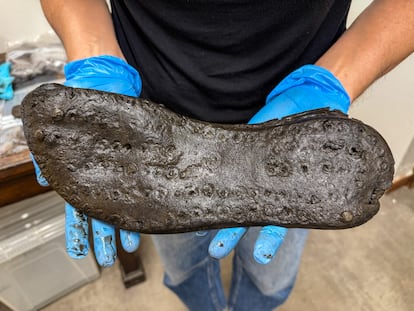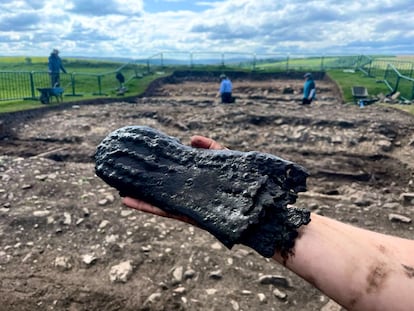Roman Giants? Oversized Shoes Found Near Hadrian's Wall


Some Romans had very large feet. Extremely large. Archaeologists have discovered eight pairs of shoes measuring at least 30 centimeters and ranging in size from 47.5 to 49.5, according to a press release published Wednesday by researchers at the site of the Roman fort of Magna . It is located in Northumberland, now the United Kingdom, Britain in Roman times, very close to Hadrian's Wall , which marked the northern border of the empire and served as a defense against the northern tribes, especially the Picts, in what is now Scotland.
In the Magna Project, which also studies the effects of climate change on archaeological work, 32 pairs of shoes were unearthed, including those of unusually large sizes. They were found in a defensive ditch that was also used as a dumping ground. Some were found in a Roman military trap known as an "ankle breaker": a narrow, deep trench camouflaged with water or mud. It was precisely the moist, oxygen-depleted clay soil, which can be altered by global warming, that has managed to keep the shoes in good condition.
That's a lot of big shoes. To put this into context: 25% of the shoes found at Magna can be considered extra-large, but at the nearby Vindolanda settlement in Hexham, 5,000 pairs of shoes have been found over the past 55 years, and only four or five were that size.
“I think something very different is happening here at Magna; even with this small sample discovered, it's clear that these shoes are, on average, much larger than most of those in the Vindolanda collection. This new Magna collection has not yet undergone the conservation process, and even considering a possible maximum shrinkage of up to a centimeter, that still means these shoes are very large indeed,” explains archaeologist Elizabeth Greene of Western Ontario University in Canada in the report. A sample of the collection can be seen at the Roman Army and Fort Museum at Magna .
Vindolanda's collection of thousands of shoes includes "tiny baby booties, elaborate summer sandals, and walking boots. These ancient artifacts spark the imagination about the type of people who wore them almost 2,000 years ago," the press release explains. Some are amazingly intact and retain decorative details, while others are badly deteriorated. Some are just a "fibrous black stain on the ground," according to the excavation blog. The largest found at Magna measures 32.6 centimeters, which could be a size 50. The mystery of the large Roman sizes remains unsolved.

"We have to assume it has something to do with the people who lived here, who may have had larger feet, possibly taller, but we don't know," archaeologist Rachel Frame, head of the Magna Project, told the BBC. Ceramics (which will help determine the exact age of the shoes), children's shoes, and what appears to be a wooden lice comb have also been found at the site.
“Organic finds like this are some of the most precious ever found at our sites, capturing the imagination of visitors and volunteers alike, but they are also the most at risk due to our changing climate. We are grateful for the support of the National Lottery Heritage Fund , made possible by National Lottery players, who have enabled the Magna project to happen. There is much more to discover about the people who lived at Magna and to understand the impact that climate change is having on this hugely important historic resource,” says Frame. Climate change , as evident at this site, also affects archaeological work, drying out the soil, deteriorating organic materials as moisture is lost, and stealing vital information.
“These finds remind us that not all populations were the same, that the vast variations between the regiments and individuals who served along Hadrian's Wall could be cultural as well as physical. Without artifacts like these wonderful shoes from Magna and Vindolanda, information like this would be almost impossible to gather. We can only celebrate and marvel at the diversity and differences of these people when we can see them in the archaeological data we are now collecting,” concludes excavation director Andrew Birley in the statement.
EL PAÍS


%3Aformat(jpg)%3Aquality(99)%3Awatermark(f.elconfidencial.com%2Ffile%2Fbae%2Feea%2Ffde%2Fbaeeeafde1b3229287b0c008f7602058.png%2C0%2C275%2C1)%2Ff.elconfidencial.com%2Foriginal%2F26a%2F2ee%2F3e1%2F26a2ee3e1694993974d02599066eb834.jpg&w=1280&q=100)


